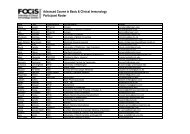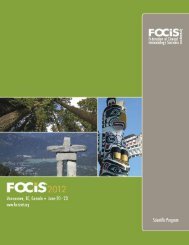Oral Presentations - Federation of Clinical Immunology Societies
Oral Presentations - Federation of Clinical Immunology Societies
Oral Presentations - Federation of Clinical Immunology Societies
You also want an ePaper? Increase the reach of your titles
YUMPU automatically turns print PDFs into web optimized ePapers that Google loves.
S6 Abstracts<br />
OR.6 Islet Antigen Specific Regulatory T Cells<br />
Isolated From Non-Diabetic Individuals Suppress<br />
Pro-Inflammatory Responses via Cytotoxic Mechanisms<br />
Timothy Tree, Lecturer, Department <strong>of</strong> Immunobiology,<br />
King’s College London, London, Jenifer Lawson, Research<br />
Assistant, Department <strong>of</strong> Immunobiology, King’s College<br />
London, London, Bart Roep, Pr<strong>of</strong>essor, Department <strong>of</strong><br />
Immunohaematology and Blood Transfusion, Leiden<br />
University Medical Center, Leiden, Hannah Edwards,<br />
Research Technician, Department <strong>of</strong> Immunobiology,<br />
King’s College London, London, England, Mark Peakman,<br />
Pr<strong>of</strong>essor <strong>of</strong> <strong>Clinical</strong> <strong>Immunology</strong>, Department <strong>of</strong><br />
Immunobiology, King’s College London, London,<br />
England<br />
Autoreactive T cells recognizing islet ? cell antigens<br />
could represent both pathogenic effectors in the development<br />
<strong>of</strong> type 1 diabetes (T1DM) and mediators <strong>of</strong><br />
tolerance in non-diabetic individuals depending on the<br />
quality <strong>of</strong> response they produce. We have previously<br />
demonstrated that, whereas autoreactive T cells in<br />
patients with T1DM exhibit polarization towards a proinflammatory<br />
T helper 1 (Th1) phenotype, the majority <strong>of</strong><br />
non-diabetic subjects also manifest a response against<br />
islet peptides, but one that shows T regulatory cell (Treg),<br />
IL-10 secreting, bias. We therefore proposed that isletspecific<br />
IL-10 producing T cells may be involved in the<br />
maintenance <strong>of</strong> tolerance to islets by the suppression <strong>of</strong><br />
proinflammatory Th1 cells. To test this hypothosis, we<br />
isolated T cell clones from healthy individuals that secrete<br />
high levels <strong>of</strong> IL-10 in response to islet antigens directly<br />
ex vivo. These CD4+CD25+Foxp3+ Tregs are potent<br />
suppressors <strong>of</strong> proinflammatory Th1 effector cells. Suppression<br />
is not mediated by soluble factors but is cellcontact<br />
dependent, and dependent upon presentation <strong>of</strong><br />
stimulating antigens for both the Treg and effector Th1<br />
cells by the same antigen presenting cell (APC), thus<br />
providing exquisite specificity <strong>of</strong> suppression. These Tregs<br />
express the cytotoxic molecules perforin and granzymes A<br />
and B directly ex vivo and mediate their suppression via<br />
the specific lysis <strong>of</strong> APC presenting high levels <strong>of</strong> islet<br />
antigens. This hitherto un-described population <strong>of</strong> antigen<br />
specific Tregs, which appear to be constitutively present<br />
in the majority <strong>of</strong> non-diabetic individuals, may provide a<br />
suitable target to strengthen tolerance to islets by clinical<br />
immunointervention.<br />
doi:10.1016/j.clim.2007.03.187<br />
OR.7 Rapamycin Promotes Induction <strong>of</strong> CD4+Foxp3+<br />
T Cells that Proliferate in Response to Common<br />
Gamma Chain Cytokines<br />
S. Alice Long, Scientist, Benaroya Research Institute,<br />
Seattle, WA, Megan Van Landeghen, RA II, Benaroya<br />
Research Institute, Seattle, WA, Jane Buckner, Pr<strong>of</strong>essor,<br />
Benaroya Research Institute, Seattle, WA<br />
We and others have shown that CD4+CD25+Foxp3+ T<br />
cells can be induced from CD4+CD25−Foxp3− T cells<br />
(iTReg). Using intracellular staining for Foxp3, we consistently<br />
observe that the CD4+CD25+ population that arises<br />
upon activation <strong>of</strong> CD4+CD25− T cells with polyclonal or<br />
antigenic stimulation is composed <strong>of</strong> both Foxp3− and Foxp3+<br />
T cells. Thus, determining factors that influence the<br />
frequency <strong>of</strong> iTReg may lead to development <strong>of</strong> targeted<br />
therapies. IL-2 is a known growth factor for natural Treg.<br />
Others have observed that treatment <strong>of</strong> patients with<br />
Rapamycin leads to an increased number <strong>of</strong> CD4+CD25+<br />
Foxp3+ Tcells. Here, we demonstrate that in vitro activation<br />
<strong>of</strong> CD4+CD25− T cells in the presence <strong>of</strong> IL-2 or Rapamycin<br />
results in generation <strong>of</strong> functional iTReg. However, combination<br />
<strong>of</strong> both Rapamycin and IL-2 results in a significantly<br />
higher frequency and absolute number <strong>of</strong> iTReg. Analysis <strong>of</strong><br />
Foxp3 over time demonstrates that up-regulation <strong>of</strong> Foxp3<br />
occurs prior to cell division and increases during the course<br />
<strong>of</strong> cell division. Foxp3− and Foxp3+ T cells proliferate in<br />
parallel suggesting that Rapamycin is not significantly<br />
inhibiting the proliferation <strong>of</strong> Foxp3− T cells, but instead,<br />
is preferentially inducing Foxp3 expression in a subset <strong>of</strong><br />
CD25− T cells. The addition <strong>of</strong> IL-2, but also IL-4, IL-7, and<br />
IL-15, facilitates proliferation <strong>of</strong> iTReg. Thus, we demonstrate<br />
that Rapamycin plus IL-2 and/or common gamma<br />
chain cytokines promotes induction and proliferation <strong>of</strong><br />
Foxp3+ T cells. These studies provide rationale for using<br />
Rapamycin in combination with IL-2 to enhance expansion<br />
<strong>of</strong> regulatory T cells in vivo.<br />
doi:10.1016/j.clim.2007.03.188<br />
OR.8 IL-2Rβ Links IL-2R Signaling with Foxp3<br />
Expression<br />
David Soper, Graduate Student, University <strong>of</strong> Washington,<br />
Department <strong>of</strong> <strong>Immunology</strong>, Seattle, WA<br />
Immunological tolerance to self-antigens is a tightly<br />
regulated process. Recent work has demonstrated that<br />
the forkhead family member Foxp3 is a critical element in<br />
the differentiation and function <strong>of</strong> mouse CD4+CD25+<br />
regulatory T (TR) cells. Recent work has suggested an<br />
important role for IL-2 in the development and maintenance<br />
<strong>of</strong> TR cells. To directly assess the effect <strong>of</strong> IL-2<br />
signaling on TR development and function, we analyzed<br />
mice that were genetically deficient in components <strong>of</strong> the<br />
IL-2 receptor (IL-2R). Mice lacking CD25 (IL-2Rα) displayed<br />
a slight decrease in TR cells within the thymus, while<br />
peripheral numbers are unchanged. In contrast, we found<br />
that mice deficient in CD122 (IL-2Rβ) had a pr<strong>of</strong>ound<br />
reduction in both thymic and peripheral TR cells,<br />
coinciding with more rapid development <strong>of</strong> a fatal<br />
lymphoproliferative disease. Expression <strong>of</strong> a Foxp3 transgene<br />
restored TR cells and protected against the onset <strong>of</strong><br />
autoimmunity. Thus, a signal mediated by IL-2Rβ is essential<br />
for the development and homeostasis <strong>of</strong> Foxp3+ TR cells<br />
in vivo.<br />
doi:10.1016/j.clim.2007.03.189




